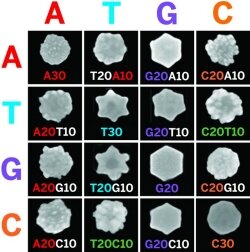Issue Date: August 13, 2012 Web Date: August 10, 2012
DNA Controls Nanoshapes
News Channels: Nano SCENE, Materials SCENE
Keywords: nanoparticles, DNA, genetic code

Researchers have systematized how the sequence of bases in a DNA molecule controls the shape and surface properties of gold-DNA nanoparticles. The findings could be used to create nanoparticles with shapes optimized for sensing, imaging, catalysis, and other applications.
Researchers often use DNA strands to help control morphology in nanoparticle synthesis, but the process has been by trial and error. Chemical biologist Yi Lu of the University of Illinois, Urbana-Champaign, and coworkers, including Jinghong Li’s group at Tsinghua University, in Beijing, have discovered the method to this madness in preparing gold-DNA nanoparticles. By systematically varying DNA sequences added to solutions used to make gold-DNA nanoparticles, they found that like a genetic code, specific sequences lead to distinct particle shapes and surface characteristics (Angew. Chem. Int. Ed., DOI: 10.1002/anie.201203716).
For example, adenine sequences induce the formation of round but rough particles, guanine DNAs yield smooth-surface hexagons, and mixed-sequence DNAs lead to mixed or unexpected morphologies—such as the flowers that bloom when cytosine-thymine DNA is used.
Lu says his group has begun extending the codes to a greater variety of sequence combinations and to other nanoparticles.
Shana O. Kelley of the University of Toronto, an expert on biotemplated nanomaterials, says others have used DNA to control the morphology of nanomaterials, but predictive ability has been elusive. “Lu and coworkers have finally achieved this by studying in detail how each base affects the growth of gold nanoparticles. The fine level of control attained is impressive,” she says.
Arizona State University’s Hao Yan, who also creates bioinspired nanomaterials, says the study “is the start of an exciting new direction” for applications such as nanophotonics, where shape-dependent plasmonic structures could enhance signals for biodetection.
- Chemical & Engineering News
- ISSN 0009-2347
- Copyright © American Chemical Society